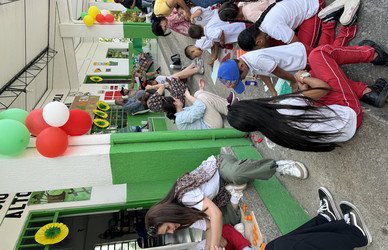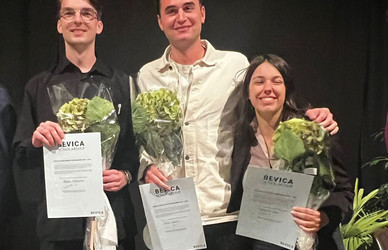The Potty Revolution
Is it inappropriate to refer to a design project as a “shitload” of good ideas? Or if you claim that it is really “shitty” if the project does not succeed? The smart comments and tired dad jokes are lining up when it comes to Ditte Marie Fog Ibsen and Julia Sand Skovsted's design project, which is about reinventing the toilet. In the future – when nature calls – we are going to sit in a totally new position – with the knees above our hips and the tailbone in the air.
Painful life for children
Undoubtedly there has been a lot of jokes and laughter during the project, which has been named ‘Poosition’, a combination of the words ‘poo’ and ‘position’. But the background for the project is certainly no laughing matter. In fact, it is pretty serious.
Every year up to 13,000 children are referred to the children's wards of hospitals with serious bowel problems and abdominal pain. The children are examined for things like tumours and bowel diseases, but only five percent turn out to be suffering from a somatic disease. The other 95 percent suffer “only” from constipation, so this is mostly an issue of bad toilet habits. "You can easily imagine the situation," the design duo explains.
"You are in the middle of a super-fun game with your friends, and you really need to go to the toilet, but you just have to... or – even worse – you have to go to the toilet in school, but the toilets are just so damp and cold and maybe you have to walk past some of those big guys in the playground. In both cases it is much easier not to go. ”And that’s when things go wrong. Because if you suppress the urge to get rid of your stools, you may permanently destroy the natural reflexes, which paves the way for constipation, diarrhoea and stomach ache.
Some 244 years in the wrong position
Ditte and Julia set out to help everyone – adults and children – develop better toilet habits. The solution has two dimensions: a fun children's book that will make it easier to talk about good toilet habits, and then something that can almost be described as a revolution, namely a toilet that actually helps us to get rid of the stuff. The shape of the toilet has not changed since its invention 244 years ago, but now a relatively new anatomical discovery is going to remedy that situation.
“Around 1990, the puborectalis muscle, which runs from the pubic bone to the tailbone, was discovered. It acts as a kind of rubber band that keeps the lower part of the intestines in place. If you stick your butt into the air, you stretch the muscle and then the poop has a clear passage out. But the toilet we use today does the exact opposite! Here you sit like on a chair, and everything is cut off. With our new toilet you lift your knees above the hips, which makes it easy to stick the tailbone in the air and thus stretch the muscle,” they explain.
Besides the excellent functionality, Ditte and Julia have, of course, also incorporated aesthetics into the design. People should have an incentive to invest in the new, different toilet as a cool design element in the bathroom. "When you design from an ergonomic perspective, it can easily look like a piece of aid equipment, but actually we work with a condition that most people will encounter at some point in their lifetime," they say.
Book about pooping in your pants
The toilet thus tackles the physical barriers to the good pooping experience for children and adults, but what about the social and psychological aspects? The designers have worked closely with chief physician Anne-Mette Walsted at the Children's Ward at Kolding Hospital to appreciate the challenges that cause so many problems for children, for example, that the repression of the urge to go to the toilet may result in a humiliating poop in the pants in front of all the friends.
“We discovered that it is hugely important to be able to talk about toilet habits, and that it can be so difficult because our stools are a big taboo. We therefore wrote the book Leo og Lorten (Leo and the Poop), which can be used in a classroom or at home to talk about good habits. It is important that children feel comfortable with their own bodies and bodily functions and that they understand what goes wrong when you feel bad. Children with constipation experience that their butt really hurts when you have to get rid of hard stools, but the book explains why it happens.”
Rinsing combats logging
The next step for the two designers, recent graduates from Design School Kolding’s Master’s programme, is to try to incorporate a rinsing function into the toilet. Sustainability is knocking on the door when it comes to our bathroom habits.
“We were quite shocked to learn that 15 per cent of the world's deforestation goes to toilet paper. That is 27,000 trees a day – right down the toilet. But in Denmark we are really good at reusing our water and for example use rainwater in our systems. So of course we must find a way to rinse our butt rather than using resource-demanding paper after toilet visits. And this is probably the hallmark of our design. What drives us is creating solutions that people really need. We do not intend to design yet another white dinner plate.”
Collaboration partner: Chief physician Anne-Mette Walsted, the Children’s Ward, Kolding Hospital



